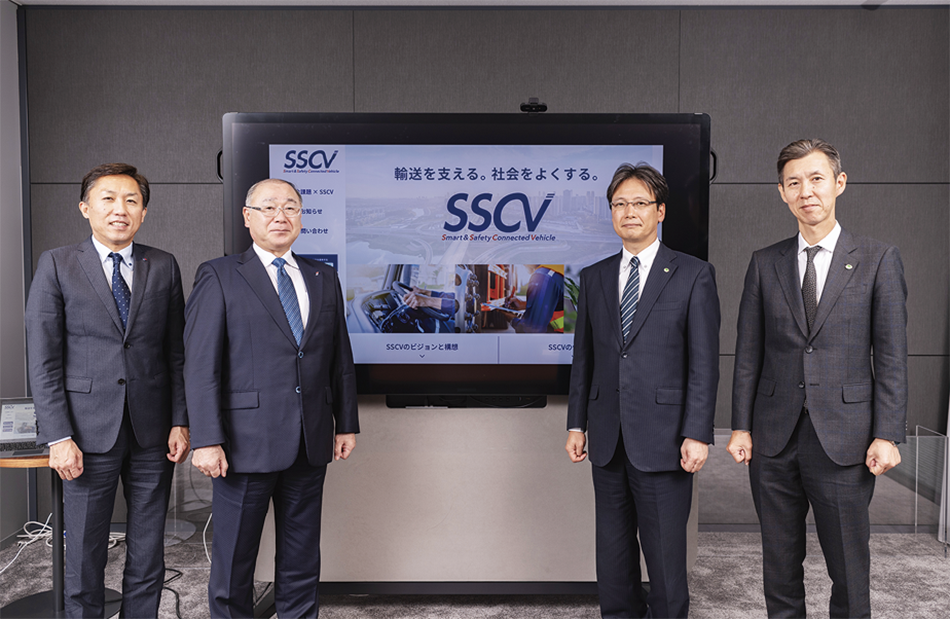COVER STORY:ACTIVITIES 2
Implementing Logistics DX that Contributes to Safety, Health, and Environmental Value
As industrial structures and consumer purchasing behavior change, logistics has become an essential part of society’s infrastructure. On the other hand, the logistics industry faces a number of challenges such as a chronic labor shortage, an aging population, traffic accidents caused by fatigue, and reducing environmental impact. To overcome these challenges, Hitachi Transport System, Ltd. has developed and offers SSCV for achieving DX where logistics can evolve. SSCV is a digital platform for transportation that enhances social, environmental, and economic value and consists of three pillars: smart, safety, and vehicle. Among the pillars, SSCV-Safety, which aims to achieve zero accidents, was developed with Hitachi, Ltd. as a collaborative partner and is now being sold externally as a Lumada solution. What is the background behind the creation of SSCV-Safety and how will it contribute to innovation in the logistics industry? Hitachi Review asked the key people involved in the collaborative project.
 Seiki Sato
Seiki Sato
Senior Vice President and Executive Officer, and General Manager of Business Management Headquarters, Hitachi Transport System, Ltd.
Hitachi Transport System, Ltd. is implementing the smart & safety connected vehicle (SSCV) platform as a new initiative aimed at realizing the digital transformation (DX) of logistics. To begin with, could you tell us about this concept?
Sato:SSCV is a digital platform for transportation that consists of three pillars—smart (efficiency), safety, and vehicle (fleet management). Currently, the mainstay of Hitachi Transport System’s business is third party logistics (3PL) services, and warehouse management operations account for a large proportion of its business, but in the transportation business overall, it is the trucks that carry cargo on-site that are the most important. SSCV is a next-generation platform that supports the basic premise of the transportation business: safe, efficient, and smooth truck operation and management. This platform makes great use of the digital technologies of Hitachi, Ltd., which joined this joint research project.
Let me briefly describe these three pillars. First, SSCV-Smart digitizes the various operations related to transportation and delivery, such as ordering, freight seeking, vehicle allocation, and operation instructions, and supports the enhancement of operational efficiency and compliance through centralized management and paperless operations. SSCV-Vehicle provides functions to optimize maintenance and improve operation rates by acquiring and analyzing vehicle travel data in real time, as well as a fleet management service (FMS) that provides integrated support for everything from vehicle procurement to purchasing.
The starting point of SSCV is SSCV-Safety, which aims to eliminate traffic accidents. The system visualizes the driver’s fatigue level based on the driver’s biometric data before, during, and after vehicle operation, and analyzes it with artificial intelligence (AI) in combination with sensing data such as images and vehicle behavior, and alerts the driver and operation manager in real time to prevent accidents. The system also supports the improvement of driving by reviewing and evaluating each driver’s driving after operation, leading to further safety improvements.
I understand that there was a strong sense of crisis behind the development of SSCV-Safety.
Sato:In 2015, when I was the general manager of the Higashinippon Area Headquarters, which is in charge of the East Japan area of our company, a series of transportation accidents occurred at the same operations site in the area. The frequency of three accidents in six months was extraordinary, and with the next accident occurring while investigating the cause and studying measures to prevent recurrence, I strongly felt that this was not the way to go. However, we could not find a clear cause even after interviewing the drivers involved in the accidents and checking the dashcams, and so we came to the conclusion that problems such as family illness and nursing care may have caused the drivers to become mentally fatigued, which was not visible to the naked eye, leading to reduced attention and distracted driving. On the other hand, the measures taken to prevent the recurrence of accidents were still based on the conventional mentality, such as thorough safety education and safety reminders before departure, and I felt there was a major discrepancy.
We thought that technological measures might be necessary, and so we tried the latest devices, such as devices that detect drowsiness and warn of collision risks, but no matter how much data we collected and examined, we could not find a correlation between driver fatigue and events that lead to accidents.
The turning point for us was the adoption, through trial and error, of the fatigue and stress measurement system, developed by Fatigue Science Laboratory Inc., which visualizes the level of fatigue based on the function of the autonomic nervous system. As a result of adopting the system, we were contacted by Professor Hirohiko Kuratsune of Osaka City University and Kansai University of Welfare Sciences, who was involved with the company. Professor Kuratsune, who is also a member of the board of directors of the Japanese Society of Fatigue Science, proposed joint research, saying, “Although a correlation between driver fatigue and driving errors may be observed, academic research on this has not yet been conducted.” And this was the impetus behind the development of the system.
 Hideaki Nagumo
Hideaki Nagumo
General Manager, Smart & Safety Solution Business Department, DX Strategy Department, Hitachi Transport System, Ltd.
Hitachi, Ltd. also participated in the joint research, but what type of system was used?
Sato:We were able to work on this project in a collaboration between industry, government, and academia, with the cooperation of our company, Kansai University of Welfare Sciences, to which Professor Kuratsune belonged at the time, and Professor Yasuyoshi Watanabe of the Institute of Physical and Chemical Research (RIKEN), together with the participation of Hitachi’s Research & Development Group.
For the first phase, we installed dashcams and other devices in some of our vehicles in FY2017 to link and analyze the biometric data of drivers measured before and after driving with image data on vehicle behavior and incidents (near-miss events) that occurred, and found a correlation between fatigue and near-miss events.
In FY2019, for the second phase, we installed the devices in all vehicles owned by our Group, and also had drivers put on wearable devices to acquire biometric data such as body temperature, blood oxygen level, blood pressure, and autonomic nervous system fatigue level before, during, and after operation, to verify the correlation between the physical state and accident risk during operation.
We learned through our demonstration experiments that it is difficult for people to sense their own physical fatigue, and even if they feel fine, they are often experiencing fatigue that is not visible to the naked eye. In the logistics industry, the aging of drivers is also a major issue, and the decline in physical fitness is a cause of invisible fatigue and sudden illness. How can we understand changes in physical state and fatigue that we do not notice ourselves, and what measures can we take in response? Hitachi Transport System is the first company in the trucking industry to focus on driver biometric data and autonomic nervous system fatigue levels as the key to measuring fatigue and to actually acquire data to prevent accidents before they occur. This was made possible thanks in part to the knowledge in the healthcare sector accumulated by Hitachi’s Research & Development Group.
Nagumo:The Global Center for Social Innovation (CSI) of Hitachi also cooperated in our joint research, and we held a number of workshops at the sites of both companies, including with drivers, to field ideas and identify issues facing Hitachi Transport System using the NEXPERIENCE* method. I was impressed by the support we received to resolve these issues in tandem with the work sites, such as when the researchers visited our offices at night after the drivers had finished their work and prepared drinks and snacks to create an environment where it would be easier for the drivers, who were not used to workshops, to talk with us.
Sato:Management, drivers, and society as a whole all share the same desire to eliminate traffic accidents. Drivers willingly participated in the demonstration experiment to help us achieve this lofty goal.
What were the key points that led to the success of the joint research through Hitachi’s participation?
Nagumo:Our goal is to achieve zero accidents, a world in which drivers are neither the perpetrators nor the victims of traffic accidents. In the field of health and safety, Heinrich’s Law is well known. It states, “For every single accident that causes a major injury, there are 29 accidents that cause minor injuries, and 300 accidents that cause no injuries (near-misses).” In other words, to prevent one accident, the signs of 300 near-miss events must be detected and eliminated. To achieve this, advanced technologies are essential, including devices that acquire biometric data and images to visualize the physical state, driving behavior, and vehicle behavior during operation; Internet of Things (IoT) technology; and AI and real-time data processing to analyze the acquired data. The fact that the Hitachi Group has all of these technologies and knowledge was a key point.
The knowledge and data obtained through a series of joint research projects were utilized to improve the accuracy of the analysis, and the results were compiled into a system that became SSCV-Safety. The system has been installed in all vehicles owned by the Hitachi Transport System Group, and we have maintained a record of zero accidents caused by distracted driving. In 2021, our company, Hitachi, Ltd., and Mitsubishi HC Capital Inc. began external sales of SSCV-Safety in order to contribute to transportation safety to a wider range of users beyond just our company. We are providing the service as “SSCV-Safety on Hitachi Digital Solution for Logistics,” a software as a service (SaaS) type service for transportation operations in a wide range of industries, including logistics, manufacturing, distribution, buses, and taxis (see Figure 1).
This is our first attempt to provide such SaaS-type services, and we were able to achieve this with the cooperation of Hitachi’s Industrial Digital Business Unit (IDBU).
Figure 1 | Three DXs SSCV-Safety Uses to Realize a Safety Management Solution 
 Motoharu Ueda
Motoharu Ueda
General Manager, Enterprise Solutions Division, Industrial Digital Business Unit, Hitachi, Ltd.
 Koichiro Yoshimura
Koichiro Yoshimura
General Manager, Distribution Systems Management Division, Industrial Digital Business Unit, Hitachi, Ltd.
How did the IDBU support the commercialization of the project? Were there any difficulties in commercialization?
Ueda:At the IDBU, we are developing Lumada businesses mainly for customers in the industrial and distribution fields. One of our solutions for customers in the logistics and transportation industry is the Hitachi Digital Solution for Logistics (HDSL), which leverages the Hitachi Group’s robust platform, security technology, high-speed processing technology for large volumes of data, and telematics technology that the Group has built as a provider of IT services. This solution provides functions to optimize transportation and delivery operations, such as automated delivery planning and IoT-based delivery monitoring. We thought that if we could add the results of Hitachi Transport System’s safety-related research on top of this, we would be able to provide new value.
Sato:Since we were creating a service that had not existed in the world before, there were some difficulties in commercializing it, such as information security and the accuracy of automatic analysis using AI.
Ueda:Yes, that’s right. This is an area of research and development, but the key was the development of technology to automatically classify and detect near-miss events using AI. The human eye can quickly determine whether a situation is dangerous or not, but it is difficult for a machine to automatically determine the degree of danger from dashcam images. To solve this problem, we developed a technology to automatically classify near-miss situations based on vehicle speed and acceleration data, location information, and map signage data. We have improved the accuracy of the analysis with the cooperation of experts by creating teaching data, defining several accident-prone situations based on actual near-miss cases, and performing machine learning for each situation. As a result, it is now possible to automatically classify near-miss cases from vehicle behavior data with a detection rate of more than 90%.
Sato:What surprised us in the actual operation of SSCV-Safety was the steady decrease in the number of incidents such as sudden acceleration or deceleration, taking eyes off the road, and speeding, which were detected in large numbers at the initial adoption of SSCV-Safety. This seems to be largely due to the advice given by the supervisor to drivers after reviewing that day’s driving after they return to base. In the case of our company, the number of incidents has been reduced by 94% when comparing January 2019 before the adoption of the system in all vehicles to March 2021 after the system was adopted. Drivers seem to resist the visualization of their driving at first, but once they realize that they gain the most important value of “safety,” they change their driving behavior. If this trend spreads outside the company, I believe it will change automotive society.
In SSCV-Safety, you are also using a newly developed dashcam.
Yoshimura:Hitachi has been developing telematics services in collaboration with automakers for about 20 years, and has been working to strengthen these services since around 2016, providing HDSL to a variety of customers. We have also developed technology to upload large volumes of data, such as dashcam video, to the cloud and process it without delay. However, in this case, since the system is required to detect hazardous events in real time during operation, the edge-side processing capacity must also be improved. In recent years, advances in device technology have increased the memory capacity of edge devices and enabled high-speed processing, and so we are developing and using this technology in a dashcam capable of collecting and processing more data than ever before.
Nagumo:In addition to a function that detects driving infractions, such as failure to stop or speeding, based on vehicle location data and map signage data, the system also has a function that estimates drowsiness by calculating the rate of eye closure from the driver’s image, and calls out to the driver to wake him or her up. Previously, it was not possible to perform this kind of diverse processing using AI installed in the edge-side dashcam. SSCV-Safety made this possible through both real-time processing by the edge AI and telematics technology that sends data to the cloud.
Ueda:As the number of vehicles equipped with SSCV-Safety increases in the future, telematics technology will become even more useful. The over the air (OTA) function also provides this foundation, making it possible to perform edge-side software updates in a short time and in a reliable manner. In this sense, this was a case of collaborative creation in which the technological foundation that we have built up meshed well with the challenges that Hitachi Transport System faced.
Health management, which considers employee healthcare from a managerial perspective and strategically implements it, has been attracting attention in recent years. SSCV-Safety can be an effective solution not only in terms of safety, but also in terms of health.
Nagumo:That’s right. We are currently conducting joint research with the Research & Development Group at Hitachi to build a system that can detect changes in the physical state of drivers based on biometric data acquired and accumulated on a daily basis, and identify signs of cardiac and cerebrovascular diseases. The theme of this research is to prevent driver diseases that cannot be fully assessed from annual health checkups and the accidents caused by them.
Monthly meetings are held to share information on joint projects and to generate ideas for the next functional development, and these meetings led to the implementation of a function called “SOS (Emergency) button.” For example, if a driver suddenly becomes distressed or has a heart attack, pressing the button automatically clips out a video clip and notifies the supervisor in real time.
We have received inquiries about whether SSCV-Safety can be installed not only in transport vehicles, but also in work vehicles and sales vehicles. If so, it could lead to health management for engineers and service staff as well as drivers.
Yoshimura:If only the functions for checking vital signs are used, it could be used to monitor the physical state of people who do not drive for work.
Sato:The SSCV-Safety system can record time, location, and images, and so it cannot be fooled. For both employees and managers, for instance, it can visualize whether employees are taking their breaks regularly. This relates directly to health management. In the case of large trucks, even if drivers try to take a break at the legally designated time, situations inevitably arise where they cannot park because the rest area parking lot off the expressway is full. When the “IoT button” on SSCV-Safety is pressed, an image of the surrounding area at that time can be recorded, and so evidence can be left behind that the driver had no choice but to exceed the legally designated time limit. In this sense, it also helps to strengthen compliance.
It is important to think of digital visualization as creating a “mechanism to accompany people,” rather than enhanced monitoring. SSCV-Safety can realize the common desire of both employees and management to protect safety and health.
What do you think about the current issues in the logistics industry, namely the 2024 problem and CO2 emission reductions for achieving carbon neutrality?
Nagumo:The 2024 problem is that the Workstyle Reform Act will set an upper limit of 960 hours per year for overtime work in automobile driving work starting April 1, 2024. If the upper limit restriction shortens the driving distance per driver, it is expected to have a major impact on the industry, such as making long-distance transport more difficult. As a countermeasure, we are developing a function that links SSCV-Safety with a digital tachograph. This function is also related to SSCV-Smart, but we need to digitalize as many operations as possible to improve the work management functions.
Sato:As long-distance transport becomes more difficult, more sharing and reloading of cargo will become necessary to shorten the travel time per person, and vehicle dispatch and delivery planning will become more complex. Digitalization is also essential for this purpose.
Nagumo:For reducing CO₂ emissions, actually, SSCV-Safety also is effective in reducing the environmental impact. In addition to helping to significantly reduce incidents, reducing sudden acceleration and deceleration improves fuel efficiency, which in turn leads to a reduced environmental impact. If we also incorporate SSCV-Smart, we can expect a reduction in CO₂ emissions through paperless operations, including those of our partner companies, by converting conventional paper documents into electronic ones.
Sato:By visualizing the dynamics of vehicles, CO₂ emissions can be shared as well as cargo. In addition, there is a possibility that the selection of modal shift will increase, and in order to select the best means of transport from the two standpoints of man-hours and CO2 emissions, it is necessary to formulate and execute a transportation plan that takes into account various factors including distance, time, environmental impact, and cost. For this purpose, we believe that a digital twin environment is necessary, and we are working to build a digital twin environment as much as possible in our 3PL business.

How can Hitachi contribute to solving the challenges facing the logistics industry?
Yoshimura:In both work style reforms and environmental initiatives, what is important is the visualization and optimization of operations through collaboration between management and the worksite. With regard to the shortening of distances, as Senior Vice President Sato mentioned, it is a question of the capability to formulate a delivery plan and implement it in on-site operations. As for carbon neutrality, the key is not only products that directly reduce CO₂ emissions, but also building up indirect measures, as in the case of SSCV-Safety. In either case, we believe that we can contribute by digital technology.
Sato:The COVID-19 pandemic has made it clear that logistics is essential work. For those of us in charge of logistics, an industry without which society would cease to function, we are required to be sustainable ourselves. To achieve this, it is important to automate as much as possible to reduce the burden on employees. Logistics is said to be a labor-intensive industry, but we need to improve the stability of our operations by concentrating on tasks that only people can perform. Currently, the entire company is working to identify such operations.
Paradoxically, the more digitalization progresses, the more important that on-site capabilities become as a key point of differentiation. I believe that DX in logistics can be used to improve safety, quality, and productivity through automation and visualization while maintaining strong on-site capabilities. And, I believe that we can lead the industry in this effort because we are a leader in this field. SSCV-Safety’s external sales are a start. If SSCV becomes the industry standard, it will contribute to society at large by eliminating accidents and reducing environmental impact, and will enhance the value of the entire transport industry. To this end, we will continue to create value through the fusion of our cutting-edge technologies in our physical domain and Hitachi’s cyber domain.
What have you learned from this collaborative creation and what are your future plans?
Yoshimura:There are many things that those of us in the information field learn only after seeing the logistics field, and so it was very important for us to understand the operational technology (OT) at worksites. If we can digitally implement the domain knowledge that Hitachi Transport System has, we can create solutions that cannot be imitated by IT-only companies.
The IDBU has been providing digital solutions to a wide range of customers in the industrial and distribution sectors, who are responsible for the series of processes from manufacturing to wholesale, retail, and the planning that connect these processes. In other words, we believe that it is important to optimize not only each individual process, but also the entire series of processes by bridging them digitally across industry kiwa (gaps). In recent years, consumer purchasing behavior has shifted to digital channels, and the shift to e-commerce is expected to continue in Japan. At that time, the importance of logistics, which bridges “the gaps,” in a sense, from upstream logistics and warehouse management to last mile delivery, is expected to increase even further. We hope to continue contributing to increasing the value of logistics through collaborative creation.
Ueda:In industries like distribution and logistics, where the supply chain is complex and there are many stakeholders, not only large companies, but also small and medium-sized businesses must work together to promote digitalization. Otherwise, the effect of connecting the entire supply chain will diminish. There are many issues in promoting DX in small and medium-sized businesses, including costs, but I hope we can take on the challenge of eliminating these problems together.
Nagumo:As SSCV is expanded from our Group to the transport industry and to various other industries, and as the number of users increases, the amount of data that accumulates will become enormous. By utilizing this data, I expect that we will be able to create new services that will contribute to society, such as the function I mentioned earlier for detecting signs of illness.
Sato:If you only look within the same industry, you may not notice many of the changes in society. However, by exchanging opinions with people from different industries and sectors, we can see things from different angles and notice things. The word kiwa means “gap,” and it may be that chemical reactions that create innovative products are born in the “gaps” between different companies and industries. I hope that this collaborative relationship will lead to further innovations in the logistics industry.